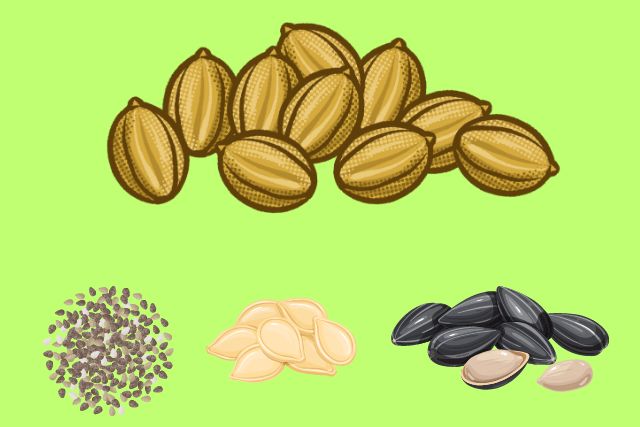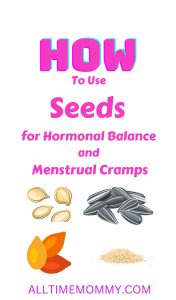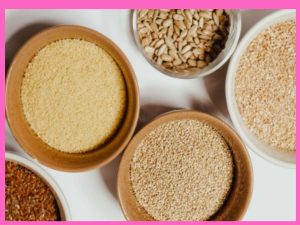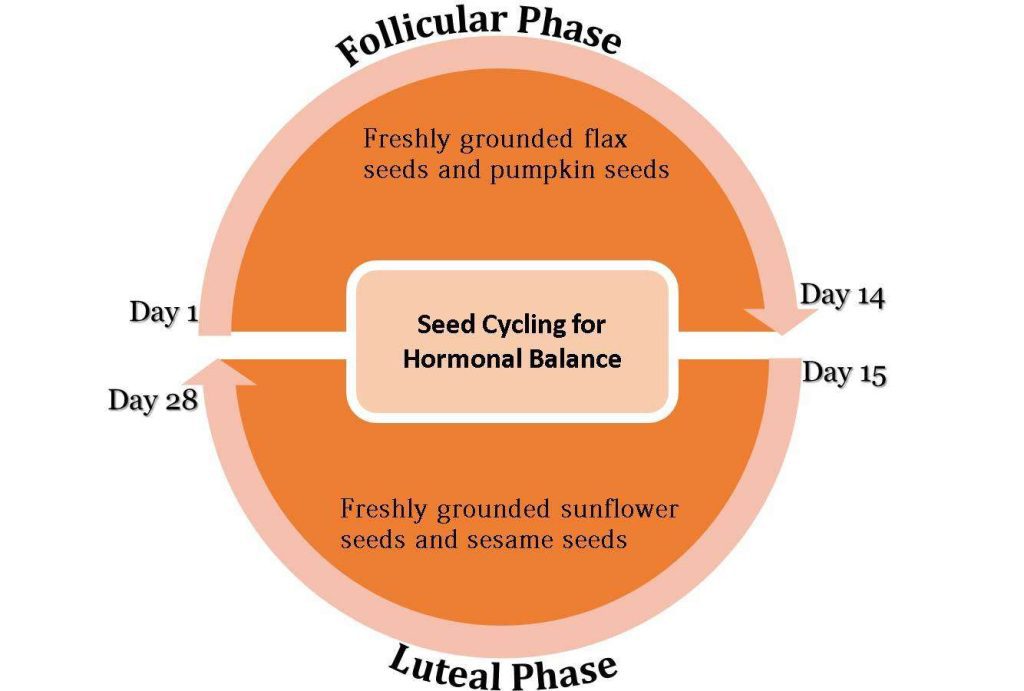Optimize your hormonal balance naturally with our in-depth guide on seed cycling for hormones. Explore the benefits of incorporating seeds into your diet to support menstrual health, alleviate hormonal symptoms, and regulate your cycle.
Are you struggling with hormonal imbalances syndromes? Seed cycling maybe your best wellness practice to embrace this year.
From studies, many women are struggling with hormonal issues. These issues come from stress, sickness, or age-related complications like menopause.
Whereas there’s a medication to help you cope with such issues, seed cycling is the natural best bait. It gives you relief from PMS syndromes without side effects.
What is Seed Cycling for Hormones?
Seed cycling entails incorporating certain seeds into your diet for hormonal balancing during your menstrual cycle.
This practice animates from the fact that certain seeds from specific plants have the properties necessary to improve reproductive health.
From claims of increased fertility to regulating periods and easing menstrual cramps, seed cycling has gained popularity and earned approvals among naturalistic.
The prescription entails consuming specific seeds in the first half of your menstrual cycle to regulate the hormone estrogen. At the same time, you take another set of seeds in the second half to regulate the hormone progesterone.
Herbalists, for instance, have rallied on Mother Nature, more specifically on certain herbs, to provide solutions for fertility. Today, researchers and health providers rely on specific seeds to relieve hormone-related disorders in women’s reproductive health.
But you may wonder;
What are the effects of having hormonal imbalances on reproductive health?
Hormones run most of the body functions. And as such, a minor distraction can be fatal. The following symptoms may occur due to hormonal imbalances;
Symptoms of high estrogen in women
- Persistent bloating.
- Breast tenderness and mild swelling.
- Fibrocystic lumps in your breasts.
- Low libido
- Irregular or heavy menses.
- Increased symptoms of premenstrual syndrome (PMS)
- Persistent mood swings.
- Persistent headaches.
Signs of Low Progesterone
- Blood clots in your menses
- Irregular periods
- Sugar cravings
- Spotting between your menses
- Shorten luteal phase probably less than 12 days
- Recurrent early miscarriages.’
- Yoni dryness.
- Abdominal pain
- Frequent Headaches
What Causes Hormonal Imbalances?
Most women in their reproductive age produce adequate hormones to support a healthy menstrual cycle.
However, some conditions, like polycystic ovary syndrome (PCOS), being overweight, hypothyroidism, and stress, can lead to a hormonal imbalance.
Additionally, age-related factors like approaching menopause may affect the levels of estrogen and progesterone. As you approach menopause, these hormonal levels may decrease. This can result in an increased risk of heart disease and frequent instances of hot flashes.
Seed Cycling and Hormonal Balancing
According to experts, four seeds have proved effective in hormonal balancing and menstrual cramps. They include;
- Pumpkin seed
- Flax seeds
- Sunflower
- Sesame seed
How Does Seed Cycling Work?
To understand how to use the seeds in your cycle, you first must understand the menstrual cycle phases. The hormonal changes in each menstrual phase are the governing principle behind which seed you should take.
Phases of the menstrual cycle and the hormonal changes
The two main phases of your menstrual cycle where you should actively involve the seeds are follicular and luteal.
The follicular phase begins on the first day of your period and ends with ovulation. That is to say, from day 1 –day 14 for women with a 28-day menstrual cycle.
In this phase, the pituitary gland releases follicle-stimulating hormone (FSH). This hormone stimulates the ovary to produce several follicles.
Consequently, the production of estrogen hormone begins and significantly increases. The increase of estrogen is to support a maturing and ripening of ovules in the ovary ready for release. You thus, need to combine certain seeds that can boost estrogen production where it’s insufficient.
Luteal Phase
Ideally, ovulation takes place on the 14 th day and marks the beginning of the luteal phase. During this phase, the egg bursts from its follicle. However, the ruptured follicle stays on the surface of the ovary.
For the next 14 days, the follicle transforms into a structure known as the corpus luteum. This corpus luteum will then, start releasing progesterone, along with small amounts of estrogen. This combination of hormones maintains the thickened lining of the uterus, awaiting implantation.
It’s worth noting however, that progesterone hormone is critical in this phase. Hence, you need certain seeds to boost its production while maintaining estrogen at a lower level.
Suppose egg implantation does not occur, the corpus luteum withers and dies. This can happen around day 22 of your menstrual cycle. The withering of the corpus luteum causes a drop in progesterone levels and, subsequent shading of the uterus lining in menstruation. The cycle then repeats.
The main aim of seed cycling is to help promote a balance between estrogen and progesterone levels—the main hormones in your menstrual cycle.
Seed Cycling Recipes
Seed cycling is a diet additive remedy for balancing estrogen and progesterone levels in your menstrual cycle.
In a typical seed cycling protocol, you eat two tablespoons of ground seeds every day. It’s crucial to have them grounded for easy absorption in the body.
Additionally, you may choose to mix the seeds into a smoothie or sprinkle them on your oatmeal. Experts suggest that you take your seeds while still raw and freshly ground.
Phase One:
It starts on the onsets of your period, that’s from day 1 to 14.
Eat a tablespoon of freshly grounded flax and a tablespoon of freshly grounded pumpkin seeds.
The high concentration of lignans in flax provides enough phytoestrogens –a compound like estrogen, which aids in regulating estrogen hormone. The phytoestrogen work by mimicking estrogen’s action. It can either increase or decrease estrogen levels depending on the need.
Pumpkin contains omega-3 ALA, zinc, and magnesium, essential elements in reproduction health. The zinc from pumpkin seeds can promote progesterone production. The production of progesterone is crucial in preparation for the next phase of the menstrual cycle.
Phase Two:
It starts from day 15 to 28 of your menstrual cycle.
Eat a tablespoon of freshly grounded sunflower and a tablespoon of sesame seeds.
During the luteal phase, lignans in sesame inhibit the increase of estrogen. The estrogen reduction helps to strike a desirable hormonal balance that supports ovulation and implantation.
Studies have linked sesame seeds to improved sex hormones and blood lipids in menopausal women. It also contains zinc, an excellent element for boasting progesterone production. Not forgetting the anti-inflammatory properties in sesame seeds which may help reduce the period cramps.
Additionally, Sunflower seeds contain vital minerals such as magnesium and iron; hence can support estrogen detoxification in the liver. The maintaining of estrogen at a desirable level helps to reduce the severity of cramps by regulating the production of prostaglandin. The vitamin E in sunflower seeds helps to boost progesterone levels.
Seed cycling in general, helps to strike a balance between estrogen and progesterone through the actions of phytoestrogens, zinc, selenium, and vitamin E.
How do you synchronize seed cycling with moon phases?
You may choose to synchronize your seeds with the moon phases. This works best for women with irregular menstrual cycles.
Days 1-14 (new moon to full moon) eat pumpkin seeds and flax seeds.
Days 15-28 (full moon to new moon) eat sunflower seeds and sesame seeds.
Seed Cycling Chart
How Does Seed Cycling Support hormonal Balance?
It is alleged that seed cycling can balance your hormones by inhibiting or promoting the estrogen and progesterone hormones. It all depends on your body needs. And it may take just a few months to notice the effects. In fact, some women have ripped the benefits within the first month.
Follicular phase
In this first phase of your menstrual cycle, Pumpkin and flax seeds help strike a balance in the production of estrogen levels. They’re neither low nor excess.
Flax seeds contain lignans which bind to excess estrogen. Pumpkin seeds are high in zinc which helps support progesterone production in preparation for the second phase.
Luteal Phase
This 2nd phase requires lots of progesterone hormones thus, Sesame and sunflower seeds become perfect candidates for boosting progesterone production.
Sesame seeds are an excellent zinc source, thus ensuring high progesterone production. It also contains lignans that inhibit high estrogen production.
Sunflower seeds are high in vitamin E and selenium, compounds necessary to boost progesterone production and foster the excretion of excess estrogen through the liver.
The Nutritional Components in Seeds
Studies have linked flax seed intake to improved cycle regularity, a prolonged luteal phase, and hormonal balance. Other researches have also shown that vitamin E in flax may ease breast pains during periods. Evidenced components of seeds include;
Lignans
Lignans are phytochemicals with estrogenic and antiestrogen properties. In seed cycle protocol, you get them in flax seeds and sesame seeds. Their role is to regulate estrogen and progesterone levels in two menstrual phases.
Additionally, they help lengthen the luteal phase, improve ovulation, and reduce common PMS symptoms such as breast pain and cramping.
Zinc
Zinc plays a significant role in female reproductive health. It is a natural oxidant with anti-inflammatory properties which help to reduce period cramps.
It is also an excellent mineral that helps to improve the formation of the corpus luteum, an essential structure for progesterone production. The corpus leteum stimulates the thickening of the uterus lining awaiting implantation.
Fatty acids and vitamin E
Fatty acids like Omega-3s and Omega-6s found in these seeds help to promote blood flow to the uterus. They also aid progesterone production in the luteal phase. This helps to maintain healthy cell membranes for implantation.
Additionally, vitamin E is effective in reducing the severity of PMS symptoms. It has antioxidant properties, which help minimize phospholipid peroxidation. It may also inhibit the release of arachidonic acid, thus preventing conversion to prostaglandins- a chemical responsible for menstrual cramps. This can significantly reduce the severity of period pains.
Selenium
Selenium is a mineral that plays a vital role in estrogen metabolism and thyroid function. Its main function is to enhance estrogen detoxification in the liver. This reduces estrogen levels, in the second phase paving way for progesterone to function effectively.
Advantages of seed cycling for fertility
Seed cycling is crucial for women, especially if you’re trying to conceive. It’s not an end to a means in itself but can significantly increase your chances of conceiving. The benefits include;
- It may promote regular periods. This is crucial if you’re trying to conceive or want to have a natural birth control method.
- Enhances the production of healthy eggs in ovaries
- Promotes proper egg implantation in the uterus in case of conceiving by boosting progesterone production
- Enhances your libido and makes your bedroom life exciting
Can Seed Cycling be Harmful?
Seed cycling is naturalistic and is usually considered as alternative medicine. Past studies have not come to a conclusive finding on its effectiveness, risks, or benefits.
Worth noting is that seeds are high in fiber, and as such, they may take up fluid in your digestive tract, thus causing constipation.
Always be sure to increase water intake if you decide to try seed cycling or any diet that incorporates seeds to avoid constipation.
Tips for Successful Seed Cycling
- Keep track of your menstrual cycle to understand the phases
- Buy raw, whole seeds instead of roasted seeds. You want to avoid exposing seed contents to high temperatures which may temper with their nutrients.
- Always consume grounded seeds for easy absorption. You may grind enough seeds to take you for a week. The trick is to store them in an air-tight container to prevent oxidation. You may choose to freeze for longer preservation.
- For better results, take your seeds as a daily supplement. Ensure that atleast you have your two tablespoons of each at your chosen time within a specific phase.
How do you include seeds in your diet?
There are several ways to consume your daily seed dosage. This includes;
- Smoothies – sprinkle your grounded seeds in smoothies.
- Salads – sprinkle them into salads
- You may Add to your drinks as you snack around e.g., yogurt and fruit juices.
- Eat them raw together with other nuts like groundnuts
- Sprinkle them on homemade bread, cookies, or muffins
When to seek medical help
Seed cycling may take some time before you notice any changes in your menstrual cycle. It can take at least three months of daily use to start reaping the benefits.
Please be patient and try to keep track of your symptoms. This may help you identify any shifts or new developments in your body. Also, you may consider seeking professional medical help in case;
- The menstrual bleeding increases
- You have not conceived past the third month
- The period pain increases
- You notice large clots in your menses.
- You continue to experience persistent headaches, fatigue, and dizziness
UP NEXT: These 12 Anti-Inflammatory Herbs Will Make Your Menstrual Cramps Go Away
DISCLAIMER The information contained in this post is for general information purposes only. I’m not a health practitioner and as such, this information should not be used as a substitute for consultation with your professional service provider.




